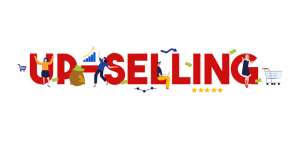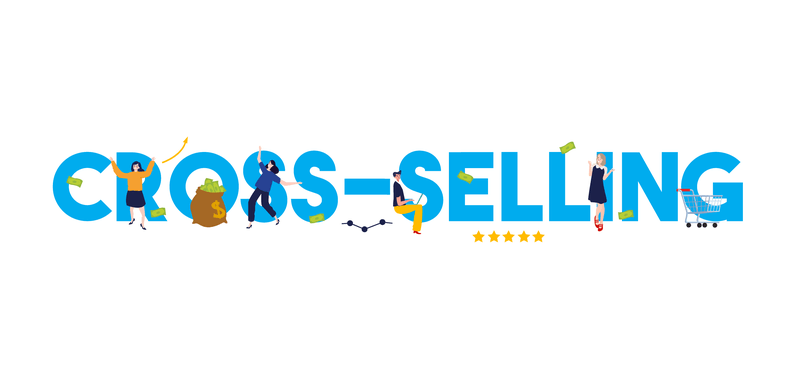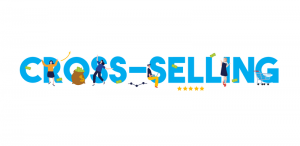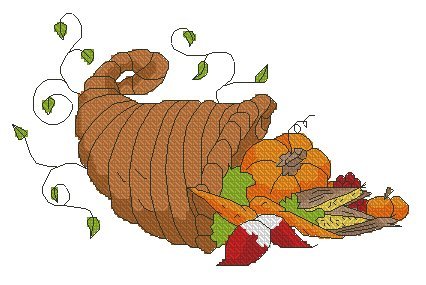Way back in 2006, when eCommerce giant Amazon was still perfecting the perfect recipe for dominating the internet, the company introduced a classic sales technique to their online storefront that vastly increased sales, helping them to achieve a massive 35% increase in profits that year.
So what exactly did Jeff Bezos and his team do to crank up sales by such a huge margin?
The answer is adding upselling techniques to Amazon product listings, a strategy that could also help your own online business to increase sales and widen your profit margins — no matter what kinds of products you sell online.
So what is upselling, and how can you leverage this classic sales technique for yourself? Let’s take a deep dive into the subject right now:
- What is upselling? — a definition
- Cross sell vs upsell sales techniques
- What is upselling?
- What is cross selling?
- How do customers benefit from upselling and cross selling?
- How to start upselling & cross selling
- Summing up…
What is upselling? — a definition
In its most basic form, upselling is a technique that successfully entices your customers to spend more money than they had originally intended. You can find examples of upselling everywhere, from online stores to bricks-and-mortar shops.
Here are a few examples of classic upsells:
- Asking a customer if they’d like to spend a little more money to get a more powerful laptop than the one in their shopping basket.
- When a car salesperson suggests that a potential buyer checks out at a more powerful or better specced model than the vehicle they are currently considering.
So far, so obvious, you might be thinking. Unfortunately, there are lots of other terms that are often used interchangeably for upselling, such as “add ons” or “bundle deals”, that are actually methods of cross selling — a very similar technique, but not strictly the same in operation.
Both cross selling and upselling are great ways to increase the “average value per transaction” at your online store, so we’ll discuss both techniques (as well as the difference between upselling versus cross selling) in this article.
Cross sell vs upsell sales techniques
Upselling and cross selling are both forms of sales strategies that involve persuading a customer to part with more money than they originally intended.
We’ll discuss the subject of ethics shortly, but suffice to say, if you believe in your products and care deeply about customer satisfaction, there’s nothing wrong with suggesting alternative items from your store that might be a better fit for your buyers — providing your motivations and recommendations are genuine.
So, before we go off tangent, here are two brief descriptions of classic upselling vs cross selling techniques:
What is upselling?

A classic upsell is making a suggestion to a potential customer that their needs would be better met by Product X, rather than Product Y that they are currently contemplating.
If you want to find examples of upselling online, head over to a big tech website such as Apple or Dell and pretend you’re in the market for a new laptop. Once you’ve found the model that you think would suit your needs, you’ll almost certainly cast your eye towards another option that offers better performance or disk space for only a modest amount of extra cash.
That’s upselling at work — and it’s extremely effective when done properly.
What is cross selling?


Cross selling is a process where you don’t try and offer a customer a better version of the product they’re already about to purchase, but instead offer complimentary additional products or add ons that they might want to buy at the same time.
In our above example, instead of trying to upsell a better specced laptop to a potential customer, you would instead offer a reasonably priced laptop bag for the device, or perhaps a free screen protector.
Both upselling and cross selling can be used to increase the “average value per customer” of your online business, ultimately meaning you’ll need to spend less money on marketing and traffic generation.
How do customers benefit from upselling and cross selling?
As we touched upon a moment ago, some business owners can be put off by these kinds of sales techniques, perceiving them as unethical and pushy. Those are valid concerns for sure, but if you approach these selling methods properly, it’s possible to actually improve the sales experience for your customers, whilst increasing your revenue at the same time:
Upselling can foster feelings of trust and confidence in your brand
If you’re inclined to think of these types of sales strategies as sleezy or pushy, take a step back and put yourself in the shoes of a potential customer: If you were suggested a slightly more expensive product than the one you were considering, but the suggestion was a much better solution for you, would you consider the company unethical or pushy?
Of course not.
In fact, if you got a sense that the business was genuinely trying to help you make the best purchase decision, you’d probably feel happy or confident using their store in the future — or even recommending it to friends.
Think of upselling as a customer service hack
If you reprogram your attitudes towards upselling and think of the techniques as ways of making your customers delighted, you’ll naturally begin to deliver better value and foster a greater sense of loyalty from your buyers.
Focus on customer service and problem solving, and the revenue will come naturally with time.
What makes upselling important for business owners?


OK, so improved profits and better customer relationships are pretty obvious benefits that come from both of these sales strategies, but are they enough to make learning the techniques worthwhile?
In a word, definitely.
For starters, improving customer experience is more likely to result in a repeat sale in the future. In addition, the type of person who chooses to upgrade their chosen product through upselling is much more likely to buy again in the future. That means successful upselling comes with two very valuable benefits:
Lowered marketing costs (and effort)
One of the hardest things to master for newcomers to eCommerce is getting their store and products found by potential customers. Traffic generation is tough — and often expensive, so it makes great sense to build a business that sells to a small but loyal bunch of fans, rather than constantly having to “cold sell” to fresh prospects:
“It is 6-7 times more costly to attract new customers than it is to retain existing customers.” – White House Office of Consumer Affairs
Whilst we’re not ignoring the importance of generating a steady flow of traffic to your eCommerce store, that statistic really ought to make you sit up and take notice about the importance of customer service and follow-up marketing.
An increased customer lifetime value
Customer lifetime value is the total amount of money a customer is likely to spend at your store over the passage of time. Here are two examples of this concept in action:
- A customer buys an item of clothing, and returns 3-4 times per year, drawn to the amazing customer service and “vibe” of the store, as well as the unique products on offer.
- A customer stops by at your store, grabs a printed t-shirt for a specific holiday or event and never returns.
In the first example, existing customers could bring a lifetime profit of hundreds of dollars. In the second example, you’ll likely earn very little at all, once you’ve factored in the costs of funnelling new customers to your store in the first place.
Overall then, it seems pretty obvious that for small business owners, customer retention is super important — and both cross selling and upselling can help with that.
Now that we’ve explored the differences between upselling versus cross selling, as well as the benefits that both of these techniques can bring to you and your customers, let’s take a look at how to upsell on your own online store:
How to start upselling & cross selling


It’s thought that upselling can generate as much as 20 times more revenue as cross selling. It’s also generally easier to persuade a customer to make an upgrade to something they already want, rather than offering them accessories and extras that they might not be interested in.
Does that mean that this technique should be avoided? Absolutely not. Both techniques can work amazingly — provided they’re used at the right time and in the correct context.
However you decide to implement upselling techniques on your website, try to remember that the internet has come a long way since eCommerce vendors started adding “you might also like” suggestions to their stores. These days, your website visitors are more savvy than ever, and won’t respond well (if at all) to gimmicky techniques.
So how can you offer an upsell to increase revenue without coming across as cheesy or desperate?
Here are a few pointers on how to start upselling and cross selling to get you started:
What products should you upsell and cross sell?
If you’re a big corporation with a product line of 20 laptops, upselling is pretty easy. However, for small businesses using a print on demand business model, it can be a lot tougher — especially if your store exclusively sells t-shirts.
Here are a few upselling examples and ideas for choosing the right products:
- Try offering a similarly designed product and point out that the item is a best seller.
- Offer the same print on demand designs in several different fabrics, and in more premium versions.
- Use testimonials and reviews, encouraging customers towards a more premium product by emphasizing quality and fit.
- For cross selling, show customers products and add ons that are complementary, but at least 50% cheaper than the main item of interest.
And here are some upselling examples that you should avoid:
- If a person is interested in buying a tablet, they won’t ever be persuaded into buying a huge desktop PC. In the same context, don’t offer a customer a thick winter hoodie if they’ve added a custom printed swimsuit to their basket.
- Don’t bombard customers with dozens of add ons and suggestions. Keep your upsells simple and relevant, or you might risk them abandoning the checkout altogether.
- It's possible to combine upselling with cross selling, but it could very easily lead to information overload.
Automation and manual tagging of your products can help you to suggest upsell products that are relevant, as well as products that are commonly purchased together. If you’re looking for tools to help you achieve this, you could try out analytics platforms like Smartlook or Woopra.
Choice is the enemy of upselling
Back in the year 2000, a study was conducted by researchers from Stanford and Columbia Universities into the effects that choice had on a person’s decision making process.
An experiment was devised whereby two food market stalls were set up — one selling a huge variety of 24 flavors of jam, the other offering just 6.
When the experiment was over, it was found that whilst shoppers initially flocked to the stall with more variety, only 3% actually made a purchase, compared to 30% for the stall with minimal flavors.
So how does the study relate to your own print on demand business?
Offering a small, more curated selection of products is probably the best approach for your online store. When it comes to upsells and cross sells, the same logic applies. Don’t push the entire contents of your store on a customer in an attempt to maximize profit — At best you’ll leave them confused, but more likely, you’ll see them abandon the checkout entirely.
There’s still a place for bundle deals
Upsells might net you more cash per customer, but a bundle deal can also be useful for increasing revenue — provided they’re used in the right context.
If you run a store with a large inventory, it can be helpful to show potential customers a selection of products that they can purchase as part of a deal. Bundles like this avoid decision fatigue, limit the amount of navigation around your site, and ultimately reduce the amount of physical and mental actions required during the sales funnel.
Bundle deals work best if they complement the main item of focus, rather than compete with it. If you’re selling a custom lunch bag, you might want to offer a printed sports bottle or insulated mug in a bundle deal, for example.
When the experiment was over, it was found that whilst shoppers initially flocked to the stall with more variety, only 3% actually made a purchase, compared to 30% for the stall with minimal flavors.
So how does the study relate to your own print on demand business?
Don’t peak too early
The whole point of these sales strategies is to either offer a more suitable product than the one a customer has chosen, or suggest other items that complement their choice, adding more value. That means you absolutely shouldn’t be offering alternative choices and suggestions before a customer has even selected a product. Those kinds of tactics might work for huge players like Amazon, but they seldom yield results for small online stores.
Wait until your visitors have selected a product, then subtly suggest useful additions and alternatives that they may prefer, and you’ll greatly increase your chances of both making a sale, and building trust in your brand.
Don’t relax once you’ve made the sale
A successful upsell is a tough skill to master, but you shouldn’t pat yourself on the back until you’ve completed the sales journey with your customer.
Think of it this way: If you’ve persuaded a customer to spend more money than they originally intended, there’s a good chance that they’re more likely to make a repeat purchase in the future — so long as you reward them for their loyalty and make them feel like a valued buyer.
As we’ve already touched upon, it’s far, far easier to nurture a relationship with a customer and turn them into a repeat buyer with strong brand loyalty than to find a completely cold prospect from scratch. That means you should always go out of your way to show your thanks and send out a small token of appreciation:
- Start by adding them to a separate email list and immediately send out a thank you note.
- Don’t be shy about explaining that you’re a new business and you really appreciate their custom.
- Offer discounts for repeat buyers or send out a free gift for existing customers who regularly return to your store.
Summing up…
Successful upselling is a tricky technique for online store owners to master, but once you get the recipe correct, it’s a fantastic way to boost your profit margins and add more value to every sale.
A successful upsell is a strong indicator that your customer could become a repeat buyer, creating strong brand loyalty in the process.
Make it happen today!
The post What is upselling & how can you master it? appeared first on Printify.







